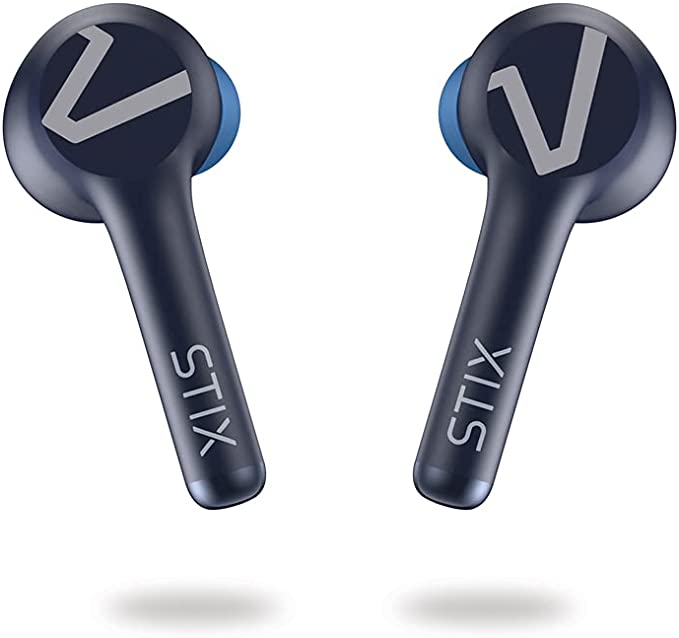Magnavox MBH513 Bluetooth Wireless Headphones: A Stylish and Capable Audio Companion
Update on June 28, 2025, 11:05 a.m.
It starts with a hunt. Not for a rare artifact in a dusty tomb, but for a cable in a tangled drawer. You rummage past the sleek, reversible USB-C connectors until your fingers find it: the familiar, trapezoidal shape of a Micro-USB plug. It feels like a relic from a bygone era, maybe five or six years ago. This small connector is your entry point to understanding the Magnavox MBH513 in-Ear Wireless EarBuds, a device that, in our age of relentless innovation, feels less like a product and more like a time capsule.
Priced at a startlingly modest $13.99, these earbuds present a puzzle. A quick glance at their online listing reveals a detective’s nightmare of conflicting clues: one section claims Bluetooth 3.0, another boasts 4.1. The item weight is listed as both a plausible 4.6 ounces and an impossible 0.71 pounds. In a world of polished marketing, this humble device wears its messy, low-overhead origins on its sleeve. And that’s precisely what makes it fascinating. It’s a piece of tech amber, perfectly preserving the moment when certain technologies became so mature, so understood, and so cheap that they could deliver wireless freedom for the price of a sandwich. So, let’s put on our archaeology hats and gently brush away the dust.

The Anatomy of a Compromise: Deconstructing the ‘Amber’
The first thing you notice about the MBH513 is its form, the neckband. This design, now often seen as a midway point between wired buds and “true wireless” pods, is a quiet masterclass in basic physics and ergonomics. By placing the heaviest components—the battery and the control circuits—into the band that rests on your shoulders, the earbuds themselves become blissfully lightweight. It’s a simple solution to the problem of gravity and ear fatigue. The in-ear tips, in turn, create a physical seal, a concept known as passive noise isolation. They don’t actively cancel sound, but they do physically block a portion of the outside world, allowing you to hear your music more clearly at a lower volume—a small, but significant, act of hearing preservation.
Digging deeper, we find its heart: the Bluetooth chip. The most likely candidate, despite the conflicting reports, is a Bluetooth 4.1 module. Why not the latest Bluetooth 5? Because 4.1 was the absolute sweet spot of its time, a pivotal moment in wireless audio. It perfected the art of coexisting with the 4G LTE signals that were becoming ubiquitous, and it was exceptionally energy-efficient thanks to Bluetooth Low Energy (BLE) protocols. It works using a clever trick called Frequency-Hopping Spread Spectrum (FHSS). Imagine you’re at a crowded cocktail party, and instead of shouting over the noise, you and your friend rapidly switch between 79 different quiet corners to carry on your conversation, thousands of times a second. That’s how Bluetooth maintains a stable connection, even in a sea of interfering Wi-Fi and other radio signals. The “up to 32 feet” range is another deliberate choice, the standard for Class 2 devices, providing enough freedom to walk around a room without the power drain of a longer-range transmitter.
And what powers this entire operation? A 150 mAh Lithium-Ion battery, promising about four hours of playtime. In a world of 30-hour audio behemoths, this seems tiny. But it’s not a flaw; it’s the core engineering trade-off. To build a device this light and this affordable, you must be ruthless with your power budget. Four hours is just enough for a daily commute, a workout, or a series of calls. This small miracle of portable energy is a direct descendant of the research that won the Nobel Prize in Chemistry in 2019. The high energy density of Lithium-Ion chemistry is what allows such a small, light power source to exist at all. The MBH513 doesn’t have a big battery, but the fact it has a battery this capable and this small is a testament to decades of scientific progress.

Ghosts in the Machine: A Brand’s Legacy and a Detective’s Dilemma
The name on the box, Magnavox, adds another layer of historical texture. This isn’t some fly-by-night brand. This is the company that, in 1972, gave the world the Magnavox Odyssey, the very first commercial home video game console. It was a pioneer. To see that name on a product that is the epitome of mature, commoditized technology creates a fascinating paradox. It’s a story of a brand that has journeyed from the absolute cutting edge to the heart of mass-market accessibility.
This brings us back to the mystery of the conflicting data. The most logical explanation is a simple one: human error in a low-margin supply chain. When you’re manufacturing a product to hit a sub-$15 price point, you don’t have a team of highly paid copywriters proofreading every detail. You have templates, rushed data entry, and perhaps different component batches over the product’s lifespan. The conflicting weight and Bluetooth specs aren’t a sign of a bad product, but a transparent glimpse into the economic realities of its creation. It’s a reminder for us, as consumers, to be critical thinkers, to understand that what we read is not always gospel, and to judge a product by its performance, not just its spec sheet.
The Verdict: The Unsung Triumph of ‘Good Enough’
After sifting through the evidence, the picture of the Magnavox MBH513 becomes clear. It is a triumph, not of innovation, but of optimization. Its brilliance lies not in the features it possesses, but in the thoughtful, almost surgical, precision of what it omits. There is no active noise cancellation, no high-fidelity aptX codec, no multi-day battery life, no companion app. It has no fat.
It is engineered to do one job: to sever the physical cord between you and your music, reliably and affordably. Every single component, from the choice of Bluetooth version to the size of the battery, is a deliberate step toward that single goal. This is the art of “Good Enough,” a design philosophy that is often overlooked in our pursuit of the “Best.” It’s about understanding the core need so deeply that you can satisfy it completely with the absolute minimum of resources.
Conclusion: Unplugging from the Hype
As I unplug the Micro-USB cable—that humble, non-reversible connector to the past—the MBH513 is fully charged and ready. It will play music, take calls, and follow commands from its simple buttons. It will do so without drama. In this small, plastic device, we find a powerful lesson. Technology’s ultimate purpose may not be to create ever-more-powerful flagships that only a few can afford. Perhaps its true destiny is to become invisible, to become so deeply integrated and so accessible that it empowers everyone.
The Magnavox MBH513 is a piece of that destiny. It’s a quiet workhorse, a technological democratizer, a fossil in amber reminding us of where we’ve been. In our endless race to the next big thing, it’s worth pausing to appreciate the silent, elegant engineering of the things that are simply, and perfectly, good enough.



























































